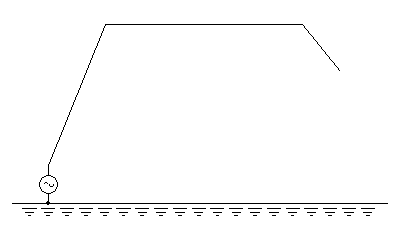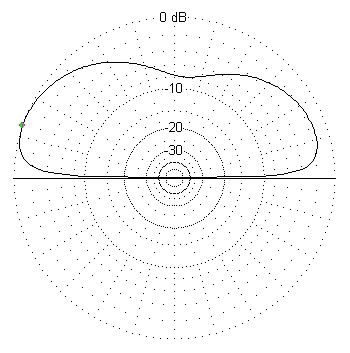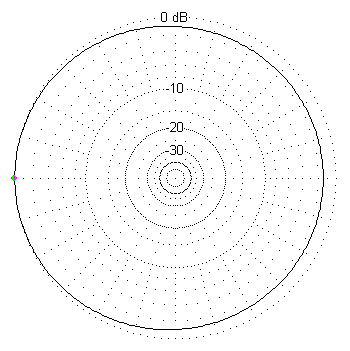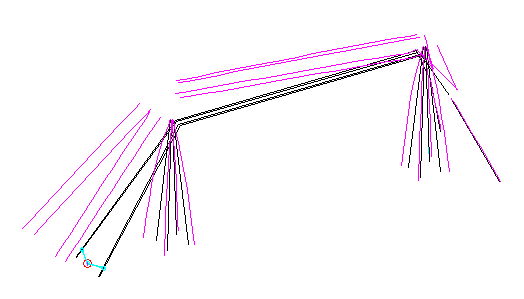
In order to get a rough idea of the performance of such antenna, it has been simulated and the gain, the radiation pattern, the antenna impedance and the current distribution has been calculated. Precise data about the structure are not available and the dimensions have been estimated via observation on site. No antenna performance data is available and therefore the result of the simulation cannot be checked against the reality and may be considerably wrong, but the figures look plausible and are reported and commented below.
The antenna of the Prangins HBG transmitter is a wire structure supported by two 110 m towers. Both towers are grounded. The matching network, situated in the transmitter building, directly feeds to cage wires that go diagonally on the top of the first tower, they than continue in the form of 5 wires horizontally aligned until the second tower. From there they are split into two groups of two wires that go down diagonally and end on two insulators at about 2/3 of the height. The wires composing the antenna are insulated from the towers. Transmission frequency is 75 kHz, one wavelength is 4000 m and a quarter wavelength is 1000 m.

Ground conductivity has a very big influence on the gain (the higher the conductivity the higher the gain), the elevation angle (the higher the conductivity the lower the angle) and the impedance. Unfortunately no information about ground conductivity is available. Even if this antenna had buried radials to increase ground conductivity, it would be very hard to bury wires at least one quarter wavelength long, therefore a value of 2 mS/m has been arbitrary chosen.
The simulation shows a gain of 1.7 dBd (including losses), an elevation angle of 19° and a half power beam-width of 55°. A very low radiation angle is important for long distance broadcast. The radiation pattern is not perfectly symmetrical, and the gain in the direction of the feed-point is higher than the gain in the direction of the open end by 1.4 dB. Therefore the antenna is not perfectly omni-directional in the horizontal plane and taking into account its geographical position, the maximum radiation is in the south-west direction. Please remark that a considerable amount of energy is radiated in a nearly vertical direction, wasting energy and probably producing interference (fading) at long distances.


The current distribution on the wires is similar to a short antenna (shorter than λ/4). The maximum current is 215 A at the feed point. In the first tower (the one close to the feed point) there is a current of 34 A, in the second tower the current is 28 A and in the two guy wires that hold the end insulators, there is a current of 1.3 A in each.
The feed impedance is (0.43 – j380) Ω, meaning that for a power of 20 kW, the feed current is about 215 A and the feed voltage is 83 kV. To have a comparison, 20 kW on a 50Ω resistive load require a voltage of 1 kV and a current of 20 A.
Now, matching a transmitter on a 0.43 Ω load is very challenging and the matching network will have considerable losses. Because of these losses, voltages and currents in the antenna will be quite lower than the simulated values.
By the way, with an impedance of (0.43 – j380) Ω this antenna really looks more like a huge 5.6 nF capacitor than an antenna!!!

The simulation shows that current flows in the towers even if they are insulated from the antenna wires. To see how the antenna would perform with no towers (or non-conducting towers), a new simulation was made. The gain is slightly lower (1.3 dBd), as well as the elevation angle (18°) and the half power beam-width (52°). The antenna is slightly less directional since the difference between front and back radiation is now only 1 dB. The feed impedance, on the other hand, is easier to match since the real part has almost doubled and is now (0.8 – j430) Ω reducing feed voltage and current to 69 kV and 160 A for the same power. The current distribution on the antenna wires is very similar than before.